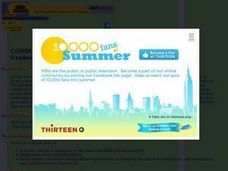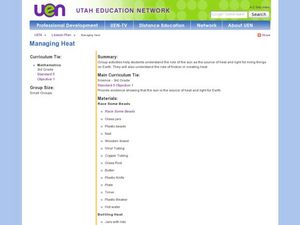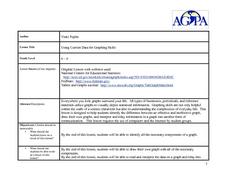Curated OER
Bermuda Today: Who Were Its Geologic Ancestors?
Students explore how the island of Bermuda came to be.
Curated OER
It's All in the Measurements
Study customary measurements with your sixth graders. They will investigate linear and capacity measurements to then measure and convert linear and capacity units. Finally they will work in small groups to conduct experiments. Resources...
Curated OER
Where Does Food Come From?
Distinguish between food and non-food items. Recognize that food is obtained from both plant and animal sources. Identify sources for some common animal foods then construct a simple food path from the farm to the consumer.
Curated OER
If I Had the Power
Have your young learners practice using higher-order thinking skills by engaging in this problem-solving activity. They work in cooperative groups to solve problems, and list ways to address a variety of challenges. They explain their...
Curated OER
Conduction, Convection, Radiation, Oh My!
Middle schoolers draw a line graph, and use graphing as a tool to discover more about conduction, convection and radiation. They should design their own experiment using heat sensitive paper to show they explain these 3 processes.
Curated OER
Managing Heat
Third graders perform various experiments to show the flow of energy that causes heat. In this heat lesson, 3rd graders understand how heat is transferred or trapped. Students use the scientific method and critical thinking skills to...
Curated OER
Fat - A Concentrated Energy Source
The role of fat as a nutrient that provides a source of concentrated energy and is also necessary for the body to utilize other nutrients, namely some important vitamins.
Curated OER
Exploration with Geometric Solids
Students reinforce geometric concepts by playing "Guess My Solid." Through a process of elimination, they determine the shapes of mystery solids. Finally, students use various materials to construct their own geometric figures.
Curated OER
It Counts
Students explore how numbers can identify objects. In this math lesson, students determine how numbers are used to describe objects used in quantitative data collection.
Curated OER
Popsicle Stick Kids
Students use popsicle sticks to make different characters. They use fabric to make the clothes and even place eyes to make them seem more real. They add jewelry and any other fashion item to complete the character.
Curated OER
The Evolution Of Bicycling Technology
Students discover how the design of bicycles has changed over time as technology has developed. They use the Web to research bicycle history and then write a report showing how technology changed the way the bicycle looks and works.
Curated OER
Mud Puddles And Bubbles
Students create muddy foot prints, "paint" with their feet, and explore the uses of bubble mix in this three-part lesson for the early-elementary classroom. The three activities can be used separately, or adapted depending on the...
Curated OER
Cloud Haiku
Students listen as a haiku is read by the teacher, determining what season is being portrayed in the poem. Students work together as a class and create a model haiku, then complete a worksheet, completing their own poem. Students will...
Curated OER
Milk and Dairy Test
Pupils explore how to select and prepare milk and milk products, identify standard serving size for milk and milk products, review terms associated with milk and milk products, and demonstrate knowledge of how to use and care for these...
Curated OER
Kimchee
Seventh graders examine the cultural food of the country of Korea. In groups, they discover different types of foods from different cultures with a focus on Kimchee. They identify the nutritional value of the food, how it affects the...
Curated OER
Food Ways - Graphing
Sixth graders choose the appropriate graph to display collected data. They interview each other on what foods they eat. They also interview elders and find out what types of food they grew up eating. They create graphs to display the...
Curated OER
Using Current Data for Graphing Skills
Middle schoolers graph demographic information. In this graphing lesson, students choose what type of graph to create and what information to display. Links to examples of graphs and statistical data are provided. The graphs are created...
CPALMS
Ice Cream Truck Favorites
[Free Registration/Login Required] During this MEA simulation, kindergarten students will determining the top three flavors of ice cream bars that an ice cream truck should serve. Students must work in cooperative groups as they work to...
Alabama Learning Exchange
Alex: You Scream, I Scream, We All Scream for Ice Cream !
Fun and yummy lesson to do on a sunny spring afternoon. Have the students take a poll of their favorite choice of ice cream and create a bar graph showing the information. This lesson plan was created as a result of the Girls Engaged in...
Alabama Learning Exchange
Alex: I Scream for Ice Cream!
In this lesson, learners will figure out how many different combinations of ice cream flavors and cones they can make. Students will work cooperatively to make the different combinations. They will use various materials to actually make...
Alabama Learning Exchange
Alex: Which Came First, Ice Cream or Refrigeration?
As students begin their study of states of matter, this hands-on activity demonstrates how the interaction of a solid and a liquid can reverse the initial state of each material.This lesson plan was created as a result of the Girls...
Alabama Learning Exchange
Alex: Ice Cream Sundae Survey
Students quickly realize the importance of learning how to read and find information in charts, graphs, and tables compared to finding the same information written in a paragraph. This is a fun, high energy lesson!This lesson plan was...























